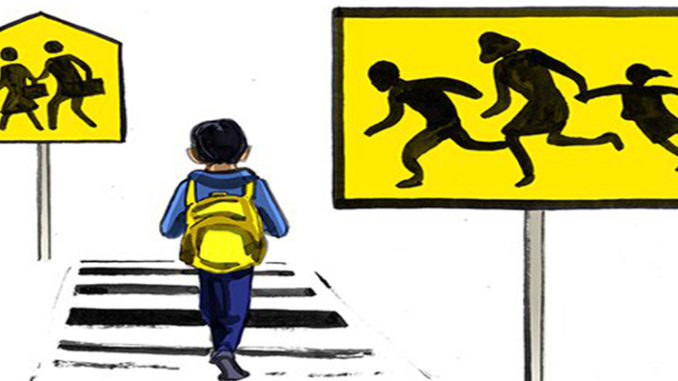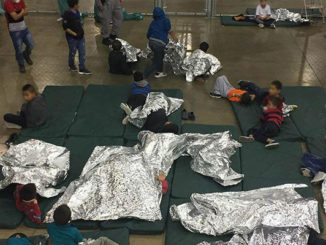
by Kavitha Cardoza
Tens of thousands of child migrants from Central America are in public schools. Many educators are working to support them, but the intensity of their needs can be a strain.
As I have spent the last several weeks talking to educators about working with migrant children, some have cried.
Their tears, they say, come from a mix of worry, empathy, and frustration with the negative, sometimes hateful, rhetoric surrounding the unprecedented flow of immigrant families across the southern border.
Reporting on migrant children—tens of thousands have come from Central America in recent years—and how they are faring in public schools across the United States as they await their final fates in immigration proceedings is difficult. Lawyers and advocates assisting children and teens are fiercely protective. The kids themselves are often terrified of talking, and not just because they worry about being deported. And the educators teaching and supporting them do not track their numbers formally because federal law requires public schools to enroll and educate children regardless of their immigration status.
I started in February, when I went to Tornillo, a small border town in West Texas, which for months had been home to the largest shelter for migrant children in the U.S. I was there to cover a protest of educators organized by Mandy Manning, the 2018 National Teacher of the Year. While the Tornillo shelter is now closed, Manning and other educators used it as a backdrop to call attention to the practice of migrant child detention and the nearly 12,000 children in over 100 shelters spread across 17 states. “We need these children to be in our classrooms,” Manning told me. “We will not stop until the detention centers close.”
When Migrant Students First Arrive
While the shelters remain full, many thousands more children who’ve crossed the border in recent years are now living with parents, relatives, or guardians and are attending schools. But it can often take weeks or months for migrant children to feel comfortable. Opening up to teachers and school staff about the experiences that have brought them to the U.S. can take even longer, if it happens at all, said Jinni Forcucci, the 2018 Teacher of the Year from Delaware. “Some of my immigrant students, they’re taught not to tell their white teachers what they’re going through,” she said.
Mandy Bucceroni, an immigration lawyer in Philadelphia, said even though her clients know she is trying to help, they are guarded. “They don’t trust people because they’ve been hurt in the past. Family members have turned on them back in their home countries, they befriend someone who becomes a gang member, who now wants to take their life if they don’t want to join. It takes a very long time and lots of meetings to gain their trust, because their stories are supposed to be buried.”
Educators I interviewed said most of the migrant children they enroll have large gaps in their schooling, meaning that many are well behind their grade levels in reading, even in Spanish. Often, migrant students who are teenagers are more motivated to find work to help support their families, rather than attend classes.
Because best practice is to place students in classes with peers and at a grade level that’s appropriate for their age, schools may have to juggle schedules to accommodate the need for migrant students to get one-on-one support from specialists. “It’s our job to catch them up,” said Scott Eastman, the principal of a dual-language school in Jackson, Wyo. “That’s a lot of work, it’s a real challenge teachers face every day. And they already work incredibly hard.”
Challenges for Schools
While many migrant students have profound social, emotional, and academic needs, most school administrators I interviewed welcome these children. John King, the former U.S. Secretary of Education, said communities have a “constitutional and moral obligation” to educate migrant students. And the educators I spoke to really believed this.
But I also encountered a lot of reluctance to talk about migrant students, including in districts such as Dallas, Miami-Dade, and Florida’s Palm Beach County, where many migrant children are enrolled.
One of the most open superintendents was Cade Brumley in Jefferson Parish, La., a politically conservative community just west of New Orleans. In this school year alone, Brumley said approximately 800 undocumented students have enrolled in his district of 50,000 children. He says he tunes out the rhetoric about immigration and what’s been happening at the border.
“And I will do whatever it takes to make every single student get the education they deserve when they walk through our doors,” he said. “Now, if that’s part of a greater political or philosophical debate, then that needs to be had outside the doors of our schools.”
Like any child coming to a new school, migrant students are encountering new peers and new teachers. But the fraught nature of being the new kid is compounded by a different language, a completely foreign culture, and, often, a fractured family life. For most of them, it’s total upheaval. Teacher Karine Welsh tries to imagine the dissonance for children who’ve gone from tending chickens with their grandparents in rural El Salvador to a giant high school in Arlington, Va., an affluent suburban district outside Washington where she teaches.
• Most come from El Salvador, Guatemala, and Honduras, Central American countries with some of the world’s highest rates of homicide, gang violence, and poverty.
• Historically, most undocumented immigrants entering the U.S. were adult males in search of employment.
• More recently, most people crossing the U.S.-Mexico border are “unaccompanied minors” and families with children, many of them who turn themselves into officials to make asylum claims.
• In fiscal year 2018, 107,000 families with children and 50,000 unaccompanied minors crossed the border, a 42 and 22 percent increase respectively, over the previous year.
• The federal Office of Refugee Resettlement served fewer than 8,000 children annually from fiscal year 2003 to fiscal year 2012, the first nine years they tracked the numbers. In fiscal 2018 alone, the agency served nearly 50,000 children.
• The numbers of migrant children appear to be accelerating. “So far in fiscal year 2019, we’ve had four record-breaking months of apprehensions of family units at the southern border,” says Sarah Pierce, a policy analyst with the Migration Policy Institute.
• Under U.S. law, all students, regardless of immigration status, are entitled to a free, public education.
Schools are making small, but important gestures to communicate to migrant students that they are welcome. Some have hung flags of different countries in hallways, some are stocking school libraries with Spanish titles, and others are making visits to migrant students’ homes to show they care and build trust.
In some communities, the enrollment of undocumented students has been constant this school year. That’s what Nicole Mitchell, the coordinator for a center that assists families with enrollment, health needs, and legal services in Los Angeles Unified, has seen. “We’re enrolling kids every day,” she said.
But steady numbers of arrivals aren’t just happening in large districts where you’d expect them. In the small, upscale resort town of Jackson, Wyo., Eastman said his dual-language school went from two migrant students to 14 in just five months. With that growth, and the state’s class-size rules, he had to add the equivalent of a new classroom midyear and the district reassigned staff from other schools to help.
“It’s definitely been a pretty significant strain on our system, one that we welcome, but it’s definitely been a strain,” Eastman said.
As migrant students flow into schools throughout the academic year, there are no funds that follow to help pay for their education. Schools must adjust with the budgets they have.
Brumley, the Jefferson Parish superintendent, said his team has made spending choices to help support this new population. They are working to hire bilingual staff for schools’ front offices and bilingual teachers to expand dual-language options.
“Your budget is simply an expression of your values and what you believe in,” he said.
Even still, recruiting teachers who are certified to teach English-as-a-second-language has been nearly impossible. Last school year, he had 15 vacancies for ESL teachers in the district’s high schools. Not a single person applied.
Suffering From Severe Trauma
Justin Mixon is an immigration lawyer in Philadelphia who represents about 200 migrant children. He said most have experienced something deeply traumatic in their home country and are forced to leave. “There’s always some other kind of plus factor—murder, rape, violence, domestic abuse. They wouldn’t normally leave their community, their friends, their language, their food, their grandparents, their culture. For many, it’s the only place they’ve ever known.”
The terrifying power of gangs—who wield more authority than police—is what drove many of the older children he represents to leave. “When these teenagers get told they either have to join or pay a lot of money or be killed, they all know the threat is real because they’ve seen dead bodies in the street.”
And during their journeys to the U.S., many are exposed to additional trauma. Students have reported seeing women being raped and fellow migrants left behind on the journey when they couldn’t keep up.
Many migrant students are frightened by school because in their home countries schools were recruiting grounds for gangs, said Erika Johnson, an ESL teacher at Wakefield High School in Arlington, Va. Showing empathy and patience is essential, she said, especially because the students express their stress in such different ways. “Some children have their head down, others act out, and others need hugs every single time you see them.”
Eastman agrees. Some students are so resilient and show no signs of what they’ve endured, he said. Others are “very, very fearful of everything,” including a 6-year-old who didn’t talk for months.
Teachers in the Prince George’s County school district in Maryland have been receiving specialized training for working with traumatized children and how to handle students’ emotions and behavior that may escalate quickly, according to Jennifer Love, a supervisor of interpreting and translation in the district. “Things can go from 0 to 100 very fast. We don’t want teachers to take that behavior personally,” Love said.
In teacher Karine Welsh’s school in Arlington, Va., students are given “flash passes” by the school psychologist, which allows them to leave the classroom without asking permission. Mitchell said Los Angeles Unified has placed psychiatric social workers in some schools, wellness centers at different sites, and different kinds of assessments and counseling for children.
Need for Professional Development
There are cultural gaps and assumptions about migrant children that can lead to misunderstandings and upsetting encounters.
In one case an advocate told me about, a migrant student came to school wearing an El Salvador soccer jersey. The school’s police officer saw the shirt and questioned the boy about possible gang connections. Upset, the student insisted he was wearing the jersey because he likes soccer and is from El Salvador.
Sarahi Monterrey, the Wisconsin 2019 Teacher of the Year, said she often sees migrant children come to class with headaches or looking sad. “I tell students all the time, ‘let me know if I need to get you water, if you need a break.’ And it’s very hard to find the right words to say because sometimes I do feel helpless.”
To better understand their needs, she attended a workshop on immigration policies and later presented what she learned to staff at her school. “I started off my presentation by saying, ‘this isn’t about our personal beliefs on immigration. We know that it’s a hot topic and anyone can have personal opinions. But this is for us as educators to understand the impact that these policies have on our students. Then we’re able to build relationships.’ ”
Eastman from Wyoming agrees. He’s spent time learning about schooling in El Salvador, Guatemala, and Honduras to better understand the expectations and experiences migrant children have. And it’s often in small moments he sees and hears that remind him of their starkly different experiences. Two 6-year-old students were recently discussing spring break. One said he was going to Denver. The other student, a migrant child, asked how far Denver is from Jackson. “About two hours by plane,” answered the first student. The migrant child responded, “no, I mean how long does it take to walk there?”
In the Prince George’s County district, where more than 5,000 migrant children have enrolled since 2014, officials are making investments in training for all staff. There are English-learner coaches for mainstream teachers, cultural sensitivity training for bus drivers, and basic Spanish-language training is offered for all school employees. And the district’s roughly 100 interpreters have undergone specialty training in vocabulary associated with emotional and sexual abuse.
Given the scale of the district’s migrant student population, professional development has been across the system.
That’s essential, said Patricia Chiancone, an international student specialist in the 133,000-student Prince George’s district, to avoid a situation where having trained staff is “hit or miss depending on what school you enroll in.” She also said it sends a strong message that “everyone has a stake in supporting these children.”
Building Trust With Families
Educators told me that when it comes to building trust and links to the families of migrant students, there are some big challenges and they must try different strategies to connect. Of course, many families are poor, and parents are working jobs that don’t allow time off to come to school events. Many come from traditions in their home countries where teachers and principals are authority figures who are not to be questioned.
Then, there are the very real fears some families have about sending their children to school when their immigration status is so precarious.
Eastman said when there are rumors of raids by immigration authorities, it creates an “atmosphere of fear,” and parents keep their children home from school. “Attendance is critical, and when students are not in school, they’re falling behind. Most kids can bounce back from missing a day or two, but the ability to do so decreases the more trauma in your home lives.”
To put families at ease, Eastman holds events for parents at a public park over a barbeque. “That’s easy for folks to access and our turnout rates are incredibly high, 90 percent.” He’s also changed how he thinks about parental engagement. Their 5th grade families sell apples to fundraise. “One parent said, ‘I can’t write a big check and I can’t come in to volunteer, but I can sell apples.’ And it’s a good example of how families find ways to participate in their child’s education. But it might not look like what you’d expect from an Anglo lens.”
Mitchell, in Los Angeles Unified, said being a reliable source of help and accurate information, is how her district builds trust. Last year, it launched a campaign called “We Are One,” a website and workshops where the district partners with a legal organization to educate immigrant parents about their rights regarding housing, health, and education.
“We take care of their children, so schools have always been that place families trust,” she said. “There’s a lot of misinformation out there and we want our families to know information that’s available, so they can make clear and accurate decisions.”
Reuniting With Long-Separated Relatives
In many families, migrant children are reuniting with a parent or parents they may not have seen in years. Some have American-born siblings they had never met. The dynamics of rebuilding—or building—these parent-child relationships are complex.
And educators see the effects of this when migrant students come to school. Chiacone said parents of migrant students have told her they are dealing with deep feelings of guilt for leaving a child behind. Some tell her they are angry that their children don’t express gratitude for the sacrifices they’ve made to support them—whether through years of sending money home or saving up enough money to bring them to the U.S. At the same time, Chiacone says some students are angry and resentful of being torn away from family and friends in their home country—the same people who looked after them after their parents left.
In an after-school club for students who’ve recently reunited with a parent in the U.S., Chiacone said students were asked to mark the level of conflict in their recently reunified households on a scale of 1 to 10. One girl, without hesitation, wrote “11.” Another educator told me about a 14-year-old boy who kept pulling the fire alarm in school. When counselors talked to him about the behavior, he told them he didn’t want to be in the U.S., that he missed the family and friends he’d grown up with. He was angry at his mother, who’d left him behind in El Salvador when he was 7.
Shouldering Adult Responsibilities
Many migrant youths had adult responsibilities in their home countries, including taking care of younger siblings, and if they could, working. The pull of earning money is strong for many, especially older unaccompanied youth who don’t want to be a burden. Paty, a high school student in Virginia, works at least 50 hours a week as a server in a restaurant to cover rent, food, and fees for her immigration lawyer.
Another student in Paty’s school, who is 16, lives alone since her parents were deported. She cleans buildings at night to pay her rent.
All migrant children are in legal limbo. They may have to attend hearings and talk to laywers. The immigration system is overwhelmed with cases and currently, it can take up to five years before a child gets a final determination on whether they will be allowed to stay in the U.S. or be deported.
One lawyer described the situation for migrant children in ominous terms, saying the U.S. is in danger of creating a “permanent underclass with children ripe for exploitation.”
Resiliency and Contributions of Migrant Students
All the educators talked to me about the many positive attributes migrant children bring to the classroom. Karina Castillo, the executive director of English-language equity and acquisition in Jefferson Parish, said meeting them, getting to know them, and understanding their stories gives her deep insight and a personal connection to what’s bringing thousands of children to the border.
“When you see the face of a child, you will have a different perspective,” Castillo said.
Ivonne Orozco understands this better than most. Now the 2018 Teacher of the Year from New Mexico, Orozco was 12 when her family illegally crossed the border into the U.S. If schools don’t serve migrant children like her, “we’re taking away that potential.”
Others list the different perspectives migrant children bring, how they expose U.S. children to different languages and cultures and the idea that there is a much bigger world out there than just their community.
“Every child has a story and every family has a story,” said Eastman, the Wyoming principal. “It just makes our community richer when we can all share those stories.”
Kavitha Cardoza is a correspondent for Education Week, reporting on education issues from pre-K through higher education for PBS NewsHour and edweek.org.



